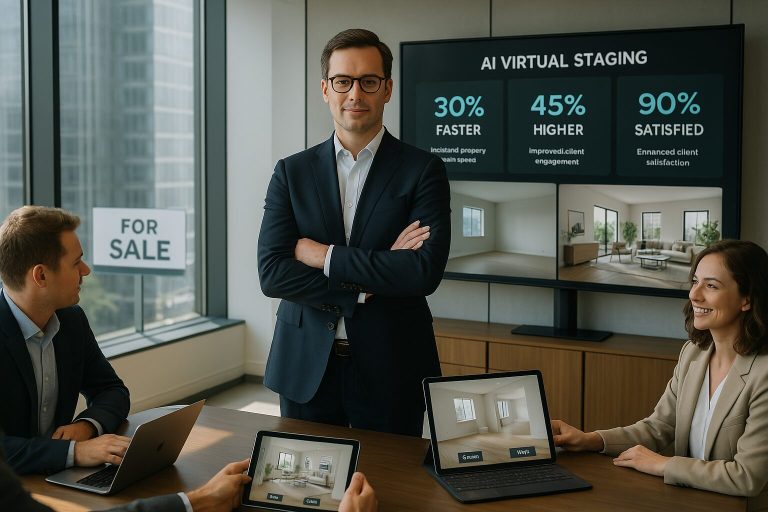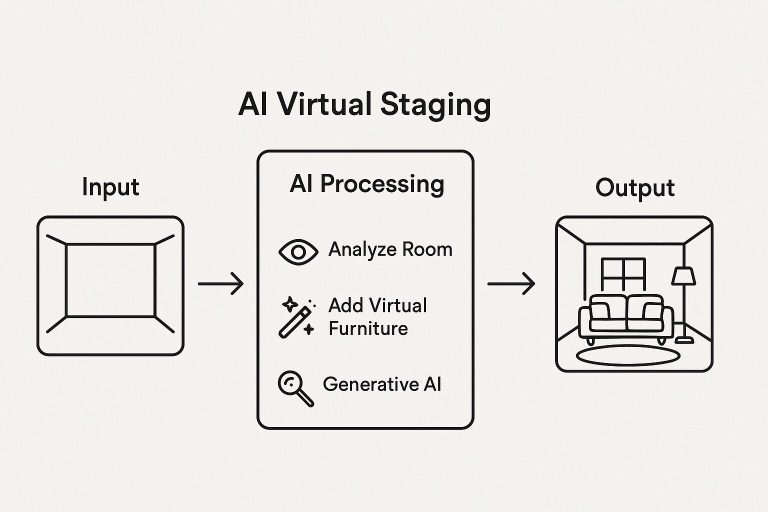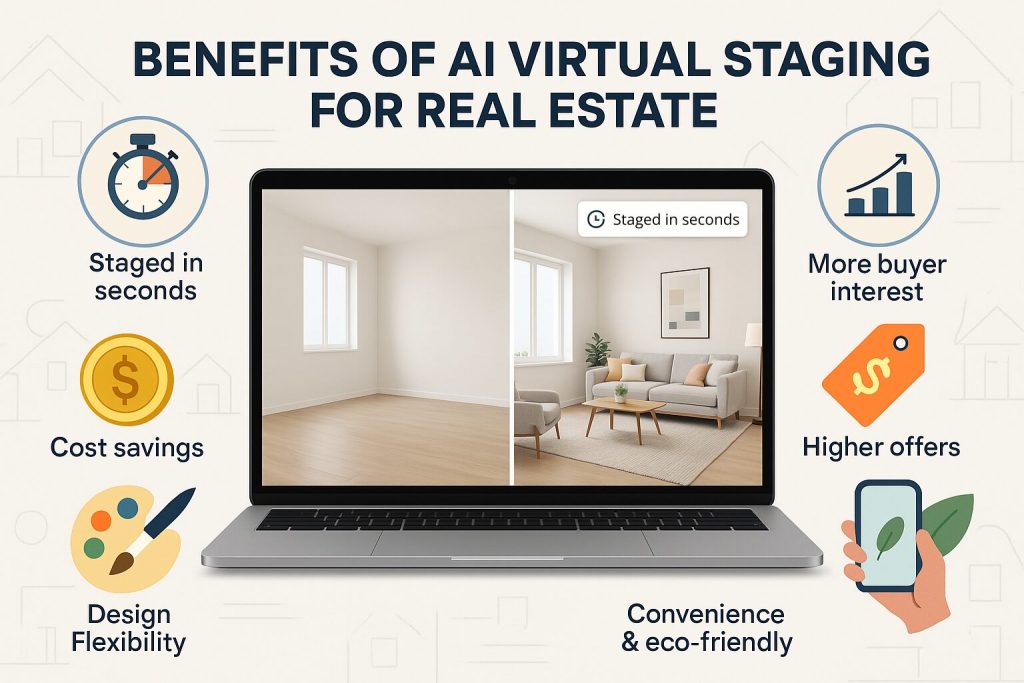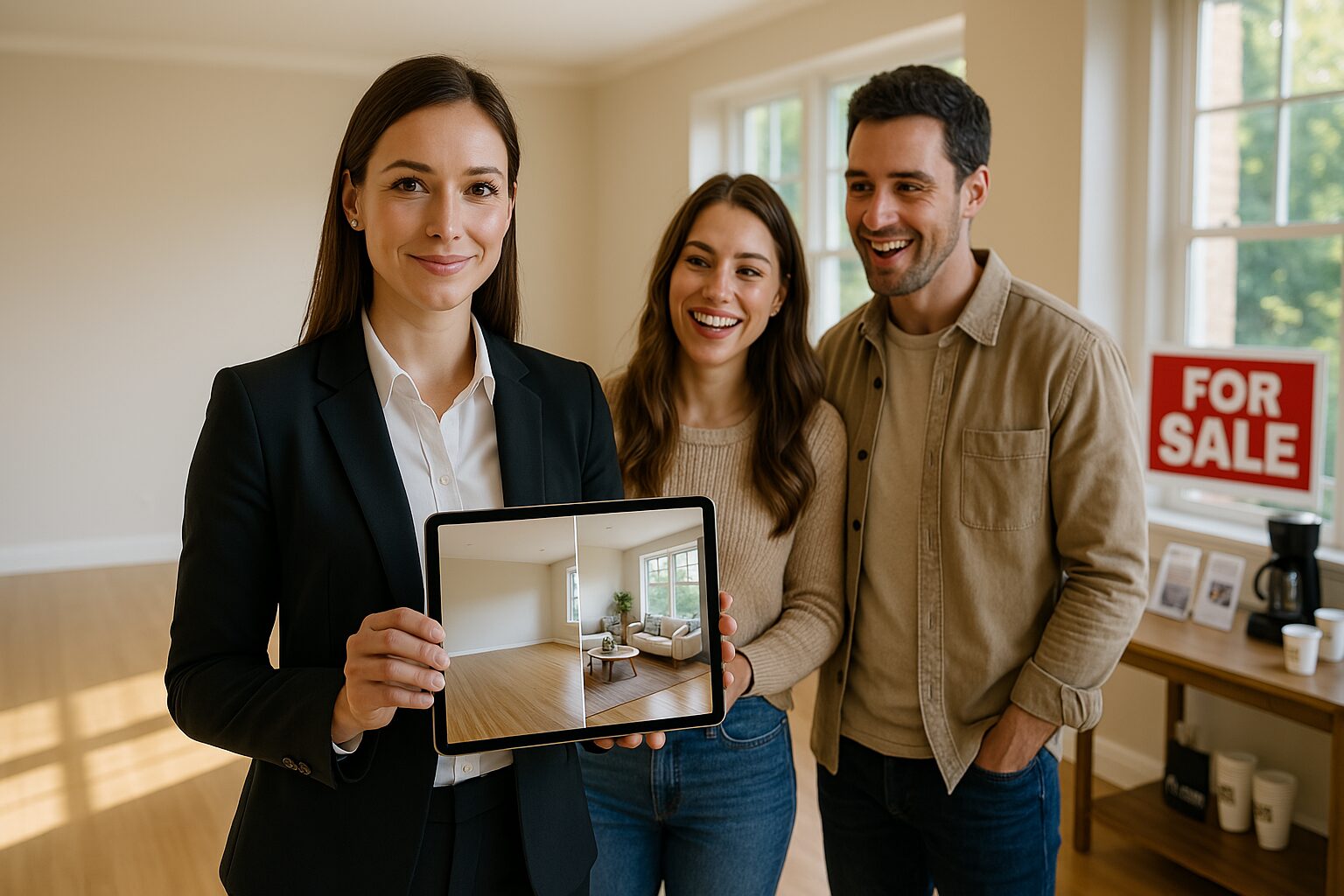In today’s real estate market, first impressions are everything – and most buyers’ first impressions come from listing photos online. For real estate agents and brokers, showcasing properties in the best light is crucial to attract interest. This is where AI virtual staging comes in as a game-changing tool. It allows you to digitally furnish and decorate empty homes in photographs using artificial intelligence, eliminating the need for costly physical staging. The result is stunning, photorealistic images of a home’s potential, created in a fraction of the time and cost of traditional staging.
In this comprehensive guide, we’ll explain what AI virtual staging is, how it works (including the tech behind it like generative AI and computer vision), and how you can use it step-by-step. We’ll also highlight the key benefits – from faster time-to-market and lower costs to increased buyer interest and even higher offers – backed by current industry statistics. By the end, you’ll see why many agents are turning to AI virtual staging to sell properties faster and for more money, and how you can do the same (with a look at solutions like InstantDeco.ai).

What is AI Virtual Staging?
AI virtual staging is a modern technique in real estate marketing where artificial intelligence is used to add realistic furniture and decor to photos of empty rooms. In other words, instead of physically staging a property with rented furniture, you can digitally stage the space. Specialized AI software analyzes a photo of a vacant (or even a poorly furnished) room and then virtually “fills” it with couches, tables, artwork, rugs, and other décor – all in a lifelike way as if the room were actually staged and photographed. The resulting images help buyers visualize what an empty property could look like as a furnished home. Traditional virtual staging (before AI) involved graphic designers manually placing furniture in photos, which could take days. AI-powered virtual staging is fully automated and can produce results in seconds. Advanced algorithms generate the furnishings with correct perspective, lighting, and shadows, so the additions look natural and convincing. Essentially, AI virtual staging offers the same visual appeal as real staging or manual virtual staging, but much faster and often at a fraction of the cost. Why is this so important now? Simply put, buyers shop online. According to the National Association of Realtors (NAR), 97% of home buyers use the internet when searching for homes (HomeJab Reveals Top Trends), and listing photos are a critical factor. Empty rooms can look cold and uninviting in photos, making it hard for buyers to imagine living there. In fact, 81% of buyers’ agents said staging (even virtually) helps buyers visualize a property as their future home (NAR 2023 Profile of Home Staging). AI virtual staging provides an efficient way to create those attractive visuals without the logistics of moving furniture. It gained even more popularity during and after the pandemic when in-person staging was harder – NAR notes that virtual staging has “taken off” in recent years, becoming a go-to tool to highlight a home’s potential (NAR Staging).
How Does AI Virtual Staging Work?
AI virtual staging leverages generative AI and computer vision techniques to create realistic staged photos. But how does it actually turn an empty room into a furnished one? The process involves a few smart steps behind the scenes:- Image Analysis (Computer Vision): First, the AI analyzes the photo of the empty room. It uses computer vision algorithms to detect the room’s surfaces (floors, walls, ceiling) and understand the perspective and lighting. Essentially, the AI “reads” the geometry of the space – identifying where a floor ends and a wall begins, where windows and light sources are, etc. This step is crucial so that any virtual furniture can be placed at the right angle and scale, with appropriate shadows and light.
- Generative Design (AI/ML): Next, a generative model (often a deep neural network trained on thousands of interior photos or 3D furniture models) gets to work. This AI model has “learned” what living rooms, bedrooms, offices, etc., look like when furnished nicely. Given the empty room photo, it generates new image content – pixels representing furniture and decor – that fits naturally into the scene. Modern approaches may use Generative Adversarial Networks (GANs) or diffusion models (similar to those behind tools like DALL-E or Stable Diffusion) to paint in couches, beds, lamps, and more that look photorealistic. The AI essentially imagines and renders the ideal decor for the space.
- Furniture Placement & Rendering: The AI not only creates virtual furniture pieces, but also “places” them in the room. It positions objects in appropriate locations (e.g., a couch against the wall, a bed in the center of a bedroom wall) and at correct size. It applies textures, colors, and lighting to match the room’s environment. Advanced AI staging platforms even let the user choose a style (modern, rustic, minimalist, etc.), and the AI will furnish the room in that style – for example, choosing a mid-century modern sofa versus a classic Victorian sofa, depending on the selected theme.
- Final Composite Image: The output is a composite image that seamlessly blends the original photo with the AI-generated furnishings. Done correctly, you can’t tell the room was ever empty – it looks like a real photo of a staged room. The AI ensures consistency in shadows and perspective so the added items appear naturally part of the scene.
Accuracy and Realism
Modern AI staging tools are remarkably accurate at producing realism. They pay attention to details like shadows, reflections, and texture of the virtual furniture. For example, if a light source is coming from a window on the left, the AI will cast shadows of the furniture towards the right, matching the lighting. The virtual furniture also has consistent texture and resolution, so it doesn’t look “fake” or pasted in. This realism is key – buyers should ideally not notice that a photo has been virtually staged (until you disclose it), they should just see an inviting, furnished room.The Technology in Action
To illustrate, imagine you have a photo of an empty bedroom. You feed it into an AI virtual staging platform. The AI recognizes the space as a bedroom (four walls, a floor, maybe a window). You select a “contemporary cozy” style. In seconds, the AI generates a plush bed with pillows and a comforter, nightstands with lamps on either side, a dresser against the wall, and a rug on the floor. The bed is placed exactly where it makes sense in the room, sized appropriately. The lighting on the bed and furniture matches the sunlight coming through the window in the photo. Voila – the empty bedroom now looks like a professionally staged master suite, ready for the listing photos. This combination of speed and quality is what makes AI virtual staging so powerful. As one NAR article put it, generative AI can “virtually stage a photo of a vacant space in 30 seconds” (NAR Generative AI) – a task that would take a human designer much longer.
Step-by-Step: Using AI Virtual Staging as a Real Estate Agent
So, how can you as an agent or broker actually use AI virtual staging in your workflow? The process is very straightforward. Here’s a step-by-step guide, using a typical AI staging platform as an example:
- Take High-Quality Photos of the Empty Property – Start with good photographs of the rooms you want to stage. Use a decent camera (a modern smartphone or a professional camera) and ensure the room is well-lit and free of clutter. The space should ideally be empty or nearly empty. (If some old furniture or clutter is present, some AI tools can remove it digitally, but results are best with a blank canvas.) Take photos from angles that showcase the room (corner angles often work well to capture depth).
- Choose an AI Virtual Staging Platform – Select a reliable AI virtual staging service or software. There are many emerging platforms; for example, InstantDeco.ai offers an easy-to-use online AI furnishing & virtual staging tool that can transform an empty room photo into a decorated room in seconds (InstantDeco’s tool can automatically furnish your room with over 50 styles). Upload your room photo to the platform – usually this is as simple as dragging and dropping the image or clicking an upload button.
- Pick a Room Type and Style – Indicate what kind of room it is (living room, bedroom, kitchen, etc.) if required, so the AI knows what furniture to add. Then choose a design style or theme from the options provided. Most AI staging platforms let you select from various interior design styles – e.g., modern, minimalist, Scandinavian, rustic, luxury, industrial, etc. This way the furniture and decor generated will align with that style. (For instance, you might choose “Modern Scandinavian” for a clean, airy look, or “Classic Luxury” for an upscale feel.) This step is where you guide the AI’s creative direction to match the target aesthetic or the likely buyer taste.
- Let the AI Work Its Magic – Now you click the “Stage” or “Generate” button. The AI will process the photo and, within seconds to a minute, produce a virtually staged image. The platform will show you the result: your once-empty room now filled with attractive furniture and decor. It’s truly a moment of delight to see the transformation. Many platforms, like InstantDeco, complete this in 30 seconds or less (InstantDeco.ai).
- Review and Refine (if needed) – Most of the time, the first result is great. But if you want, some tools allow minor tweaks. For example, you might regenerate with a different style to compare looks, or adjust an item (some platforms let you swap a piece of furniture or correct something if the AI made an odd choice). In general, AI staging is less customizable item-by-item than manual virtual staging, but you can always rerun with a different style or send a note if using a service. Ensure that the final image looks realistic and meets your expectations for showcasing the property.
- Download the Staged Photos – Once satisfied, download the high-resolution staged images. These are now ready to be used in your marketing: add them to your MLS listing, your website, flyers, social media, etc. Be sure to label them as “virtually staged” when listing, to be transparent (many MLSs require disclosing if photos are digitally altered). This ensures buyers know the furnishings are digital and not included with the property – it manages expectations while still wowing them.
- Use in Listings and Marketing – Now your listing can shine. Compare an empty photo vs. the staged photo – the difference in emotional impact is huge. By uploading the virtually staged photos to your listing, you make the property more attractive to buyers browsing online. Highlight in the description that the home is shown with virtual furnishings for visualization. You can even print them for brochures or use in virtual tours. The home will likely get more interest and potentially more offers thanks to this enhanced presentation.
That’s it – no movers, no furniture rentals, no waiting days for a stager. The process from snapping a photo to having a beautifully staged image can be well under an hour (mostly spent taking photos). Many agents integrate this into their listing preparation: photograph the home one day, and the same day you can have all the marketing images staged and ready to go live.

Benefits of AI Virtual Staging for Real Estate
Why should real estate professionals use AI virtual staging? Here are some key benefits of this technology, and how it can give you and your listings an edge:- Faster Time-to-Market: AI virtual staging dramatically speeds up the listing process. Physical staging can take days or weeks to schedule (not to mention a day to actually stage and photograph). Even traditional virtual staging by a designer takes 24-48 hours per photo. In contrast, AI can stage a photo in seconds. This means you can list the property faster, with beautifully staged photos ready almost immediately. Faster turnaround leads to more timely listings and the ability to capitalize on market momentum. If you have a tight timeline to get a property on the market, AI staging is a lifesaver. For example, rather than waiting a week for staging, an agent can have a home photographed and virtually staged on the same day, going live to buyers sooner.
- Lower Cost (Staging on a Budget): Staging traditionally isn’t cheap – renting furniture and hiring stagers can cost thousands. NAR reports that staging a property can cost as much as $2,800 on average (NAR Generative AI), and even virtual staging with a human editor might cost $30+ per photo. AI virtual staging, on the other hand, is extremely cost-effective. Once you have the tool or service, the cost per photo can be a few dollars or less. One NAR article noted AI can virtually stage a photo for as low as a few cents in certain cases (of course, many services might charge a small fee, but it’s still typically under $20 per image, and often volume packages reduce that further). In any case, you’re looking at paying maybe $100 or a few hundred total to stage an entire home with AI, versus potentially $2,000–$5,000 for traditional staging (LCP Media). That’s a huge savings – up to 90–97% cheaper in some comparisons. For agents and sellers on a budget, virtual staging allows you to enjoy the benefits of staging without the hefty price tag.
- Increased Buyer Interest and Engagement: Attractive photos draw more eyeballs. When a home is virtually staged, it tends to get more interest online. According to NAR’s 2023 Profile of Home Staging, 40% of buyers were more willing to walk through a home they saw online that was staged (even virtually) (NAR 2023 Profile). That means more buyers turning from online viewers into in-person visitors – a crucial step in selling a home. Additionally, stunning images can lead to more clicks and saves on listing sites. Some studies have found that listings with staged photos get significantly more views than those with empty rooms. By helping buyers visualize the space (remember, 81% of agents say staging helps with visualization), you keep them engaged longer on your listing and emotionally connect them to the home. In short, virtual staging can make your listing stand out from the crowd of empty-room listings, attracting more potential buyers.
- Higher Offers & Faster Sales: Ultimately, staging (physical or virtual) isn’t just about making things pretty – it’s about influencing the sale. And the data shows it works. Homes that are staged tend to sell faster and for more money. For example, a survey by the Real Estate Staging Association found staged homes sold 73% faster on average than unstaged homes. Even NAR’s studies confirm that many agents see quicker sales: 31% of sellers’ agents reported that staging significantly reduced the time a home spent on the market (Irina Norrell). Buyers may also be willing to pay more for a home that they fall in love with through the photos. NAR’s 2023 report noted that 23% of buyers’ agents observed a 1–5% increase in the dollar value offered by buyers for staged homes compared to similar unstaged homes. Even a few percent premium on a home price (thanks to that great impression and emotional pull from staging) can mean thousands or tens of thousands of dollars extra for the seller. Some agents have reported instances of even higher uplifts when a home is beautifully presented. While results vary, the consensus is clear: virtual staging can pay off in real dollars by inspiring higher offers and possibly sparking bidding wars. And because it helps sell homes faster, carrying costs and price reductions are minimized. It’s a win-win.
- Flexibility and Creative Freedom: With AI staging, you also gain marketing flexibility that’s hard to achieve otherwise. You can stage the same room in multiple styles to target different buyer demographics – for instance, one image of a spare room as a home office, and another image of that same room as a children’s bedroom. You could never do that physically for one listing, but digitally it’s easy. This helps buyers see the versatility of a space. You can also quickly update photos if you want to try a new design trend or seasonal look. Got a luxury condo listing? You can virtually stage it in an ultra-modern style for one set of buyers, and also show a warm traditional decor for another set – and use both in your marketing to broaden appeal. The home can wear many “outfits” in the listing photos, courtesy of AI. Moreover, you don’t have to worry about moving heavy furniture around or the limitations of real furniture availability. The entire catalog of styles and pieces lives in the AI, ready to apply to your photos. This creative freedom lets you custom-tailor the staging to what you think will resonate best with likely buyers (even testing different looks to see which gets better response).
- Convenience and Safety: Especially if a property is occupied or has tenants, physical staging can be intrusive and inconvenient. Virtual staging is non-invasive – you can leave the property as-is and just work with photos. During the COVID-19 pandemic, this was a huge advantage, and even now it means less disruption to sellers. Additionally, there’s no risk of damage to the property (no furniture being lugged in and scraping floors, etc.). It’s also eco-friendly – no trucks or physical materials, just pixels. Overall, AI staging is a very convenient option that simplifies the selling prep process.

Industry Statistics: The Impact of Virtual Staging
Let’s recap some powerful numbers that show how virtual staging (including AI-driven staging) is impacting home sales:
- 81% of buyers’ agents say that staging a home helps buyers visualize the property as their future home. This underscores why staging is done – it helps create that emotional connection and understanding of the space.
- 40% of buyers are more likely to walk through a home they saw online that was staged. In other words, staging attracts more potential buyers to come for showings, which increases the chances of a sale.
- 73% faster sales on average for staged vs. unstaged homes (Real Estate Staging Association study). While figures can vary, it’s clear that staged homes spend significantly less time on the market in many cases.
- 1–5% increase in offers for staged homes, as reported by 23% of agents (and some saw up to 10% higher offers). Even a modest percentage increase can be a big dollar amount. For a $500,000 home, 5% is $25,000 extra!
- 97% of home buyers search online for homes – making quality listing photos (and thus virtual staging) incredibly important for grabbing attention in those online searches.
- Virtually staged listing photos get more views and inquiries. (For example, one report noted staged photos generate more website views and can help sell/rent a property up to 73% faster than the competition.)
- Cost savings ~90%+: Traditional staging can cost $2k–$5k per listing, whereas virtual staging often costs a few hundred dollars or less. That’s a reduction in cost by roughly 80–97%, which is significant for owners and agents.
These statistics reinforce that virtual staging isn’t just a gimmick – it has a real, measurable impact on real estate outcomes. Buyers are demanding better visuals, and staged homes deliver that, translating into faster and more profitable sales. As AI makes virtual staging easier and more affordable, we can expect these trends to grow even stronger.
Embracing AI Virtual Staging – The Future of Home Marketing
AI virtual staging is more than a buzzword; it’s quickly becoming an essential part of the real estate marketing toolkit. For agents and brokers, it offers a way to elevate your listings without blowing the budget or timeline. High-quality visuals lead to higher engagement from buyers, which leads to faster transactions and happy clients.
If you haven’t tried AI virtual staging yet, now is a great time to start. Many platforms offer free trials or low-cost per-image pricing. For instance, InstantDeco.ai’s virtual staging feature is an innovative solution that can automatically furnish empty rooms in just seconds, letting you choose different design styles at the click of a button (all through a user-friendly online interface). By leveraging such AI tools, even smaller agencies or individual agents can compete with big-budget listings in terms of presentation.
Finally, it’s worth noting a couple of best practices as you embrace this technology:
- Always disclose virtual staging. Be transparent that certain photos have been digitally staged. This is both an ethical practice and often a legal/MLS requirement. Typically a simple note “virtually staged” in the MLS photo caption is enough. Buyers understand that the furnishings aren’t real; as long as the images aren’t misleading (e.g., don’t add a window or remove a wall – stick to adding furniture only, which is the norm), virtual staging is seen as a helpful visualization tool.
- Use AI staging to complement, not deceive. The goal is to help buyers imagine possibilities, not cover up defects. So, don’t virtually paint over damage or make changes to the structure – keep it to furnishing and decor, which buyers know is not part of the sale. This way you maintain trust while still reaping the benefits of a beautiful presentation.
- Pair images (empty and staged). It can be useful to show both the unstaged and staged photo in your listing (or have unstaged available on request). This shows the actual property condition but also the potential. Many agents include one photo with a label “virtually staged” and another of the same room empty labeled “actual view” or similar. This full disclosure can actually build confidence and still wow the buyers.
The bottom line is that AI virtual staging can significantly enhance your real estate marketing efforts. It’s fast, affordable, and effective. By defining spaces and inspiring buyers, it helps you sell properties more efficiently. As the technology continues to advance, we may soon see even more interactive staging (imagine letting buyers toggle styles in an online listing, or view virtually staged rooms in 3D/VR). For now, static photos with AI staging are already a huge leap forward.
Real estate is a business where embracing innovation often separates the best from the rest. AI virtual staging is one such innovation – it empowers you to present any property in its best light, regardless of its current state. In a competitive market, that’s an advantage you can’t afford to miss. So, go ahead and give AI staging a try on your next empty listing. Your sellers (and your wallet) will likely thank you when the offers roll in.
